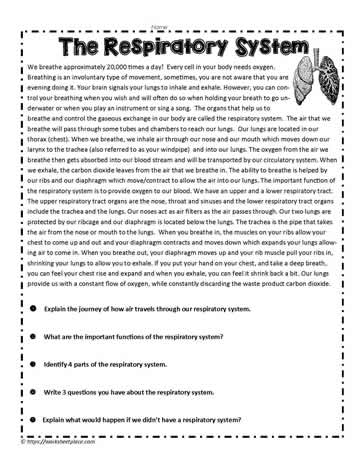| |||||
| Respiratory System Comprehension For Google Apps | |||||
| Can you imagine we breathe more than 20,000 times in one day? Your brain signals your lungs to inhale and exhale. You do it so often you are not even aware of it. Use this worksheet to teach important facts about the respiratory system to your kids. Questions will follow. We breathe approximately 20,000 times a day! Every cell in your body needs oxygen. Breathing is an involuntary type of movement, sometimes, you are not aware that you are evening doing it. Your brain signals your lungs to inhale and exhale. However, you can control your breathing when you wish and will often do so when holding your breath to go underwater or when you play an instrument or sing a song. The organs that help us to breathe and control the gaseous exchange in our body are called the respiratory system. The air that we breathe will pass through some tubes and chambers to reach our lungs. Our lungs are located in our thorax (chest). When we breathe, we inhale air through our nose and our mouth which moves down our larynx to the trachea (also referred to as your windpipe) and into our lungs. The oxygen from the air we breathe then gets absorbed into our blood stream and will be transported by our circulatory system. When we exhale, the carbon dioxide leaves from the air that we breathe in. The ability to breathe is helped by our ribs and our diaphragm which move/contract to allow the air into our lungs. The important function of the respiratory system is to provide oxygen to our blood. We have an upper and a lower respiratory tract. The upper respiratory tract organs are the nose, throat and sinuses and the lower respiratory tract organs include the trachea and the lungs. Our noses act as air filters as the air passes through. Our two lungs are protected by our ribcage and our diaphragm is located below the lungs. The trachea is the pipe that takes the air from the nose or mouth to the lungs. When you breathe in, the muscles on your ribs allow your chest to come up and out and your diaphragm contracts and moves down which expands your lungs allowing air to come in. When you breathe out, your diaphragm moves up and your rib muscle pull your ribs in, shrinking your lungs to allow you to exhale. If you put your hand on your chest, and take a deep breath, you can feel your chest rise and expand and when you exhale, you can feel it shrink back a bit. Our lungs provide us with a constant flow of oxygen, while constantly discarding the waste product carbon dioxide. | |||||

All worksheets are created by experienced and qualified teachers. Send your suggestions or comments.